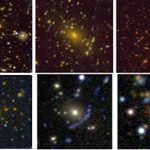Author Archive
The cosmic microwave background is the radiant heat left over from the big bang. It was emitted nearly 14 billion years ago, just 380,000 years after the big bang, and has traveled across literally the entire observable universe. This makes the CMB an ideal backlight to find the most massive, distant structures in the universe,… More »
Last month the Holometer, Fermilab experiment E-990, reached its design luminosity, building up more than 1 kilowatt of infrared laser power stored in a 40-meter-long Michelson interferometer. This light intensity corresponds to more than 1022 (ten billion trillion) photons per second hitting the interferometer optics. It also allows scientists to measure the optics’ positions to… More »
The Dark Energy Survey collected more than 34,000 exposures during its science verification (SV) phase, from November 2012 to February 2013. It also began its first official season of observations on Aug. 31. Among the millions of astronomical objects imaged by DES so far, there are rare instances of “strong lensing” systems, where the effects… More »
The headline story in the April 15 issue of Fermilab Today featured the observation by the CDMS experiment of three candidate events that could have been produced by dark matter. That result, combined with several other possible signals, points to a dark matter candidate that is much lighter than expected. While no one is claiming… More »
Scientists around the world are trying to understand the nature of dark matter, which accounts for most of the mass of the universe. The earth seems to be moving through a cloud of dark matter particles that encompasses the visible parts of our galaxy. We should be able to sense this dark matter, if we… More »
The Fermi bubbles extend tens of thousands of light years north and south of the Galactic Center—the center of the Milky Way—and are likely the consequence of a very active period in the recent history of the galaxy, maybe having to do with the rate of star formation in the inner galaxy or with an… More »
After getting the first light in the mid of Sept., 2012, the DES team is flashing forward at amazing speed. By the end of 2012, we have successfully completed the commissioning and science verification, and the formal survey will start at the beginning of 2013. During the first of the five survey seasons, DES is… More »
The cryostat and time projection chamber for the SCENE experiment (SCintillation Efficiency of Noble Elements) were recently installed at the FN Tandem Van de Graaff Accelerator at the University of Notre Dame. Neutrons emitted from a lithium-fluoride target produce recoiling argon nuclei – the same signature expected for Weakly Interacting Massive Particles – in the… More »
The Dark Energy Survey (DES) will use its newly constructed camera, DECam, to observe a large swath of the southern sky out to vast distances in order to provide new clues about the nature of dark energy or why the universe’s expansion is accelerating. The DECam imager was designed and built at Fermilab over the… More »














